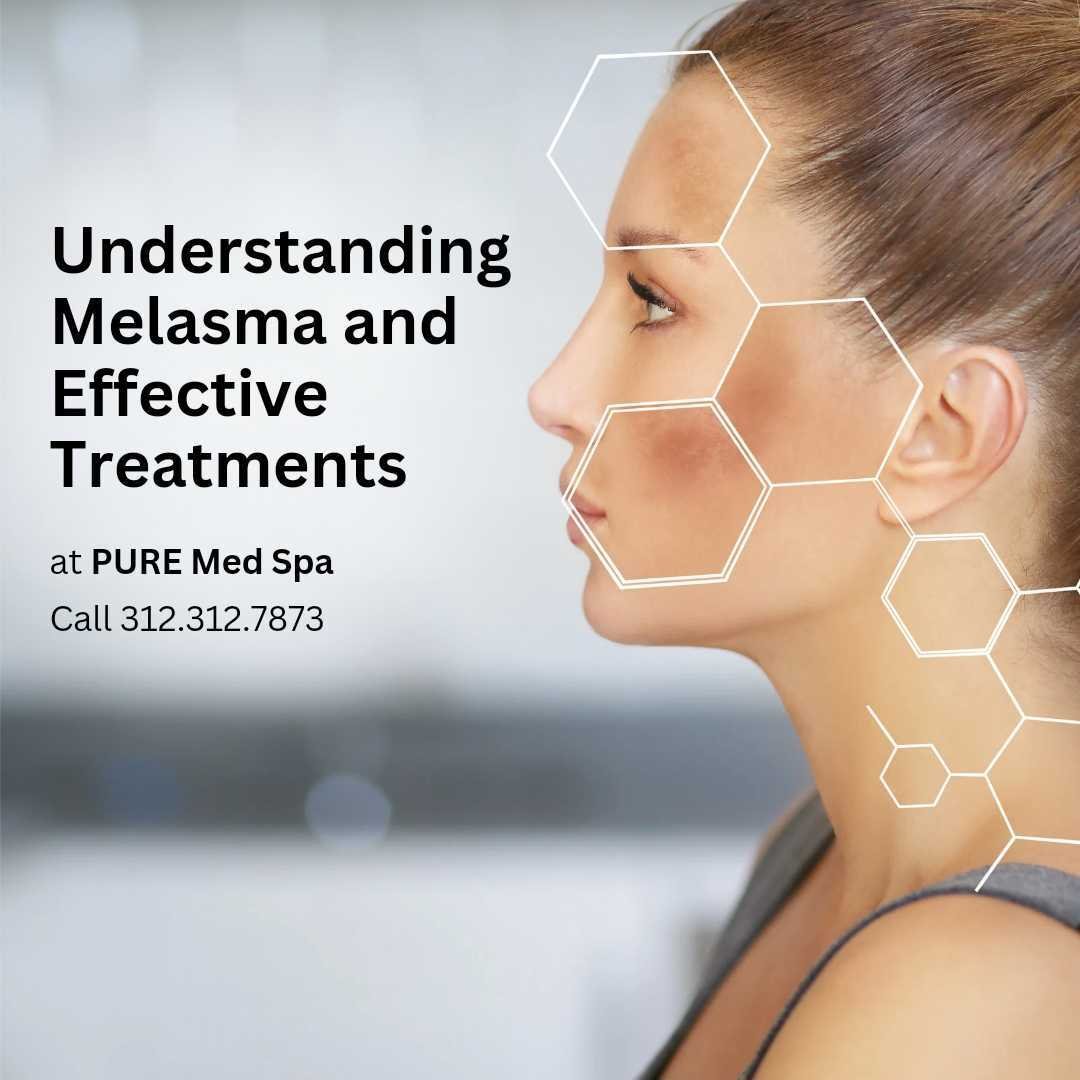Melasma is a common skin condition characterized by brown or gray-brown patches, primarily on the face. It often affects the cheeks, forehead, bridge of the nose, chin, and above the upper lip. While melasma is not harmful, it can be a source of cosmetic concern for many. Understanding melasma and exploring the best treatment options is crucial for those looking to manage and reduce its appearance effectively.
What Causes Melasma?
Melasma is a skin condition that can be influenced by several factors, including sun exposure, hormonal changes, genetics, and certain medications. Each of these elements can contribute to the development and worsening of melasma in different ways.
- Sun Exposure
Sun exposure is a major cause of melasma. When your skin gets UV light from the sun, it triggers pigment-producing cells, leading to dark patches. UV rays can even reach you through clouds and windows, so it’s important to use sunscreen and avoid direct sunlight to manage and prevent melasma.
- Hormonal Changes
Hormonal changes are a big reason for melasma. It often happens in women because hormones affect skin colour. Melasma can show up during pregnancy, sometimes called the “mask of pregnancy.” It can also get worse with birth control pills or hormone therapy.
- Genetics
Genetics play a role in how your skin responds to various triggers. If you have a family history of melasma, you may be more predisposed to developing the condition yourself. Genetic factors can influence how your skin produces and manages pigment, making some individuals more susceptible to melasma than others.
- Medications
Certain medications can also contribute to melasma. Some drugs, especially those that affect hormone levels, can lead to changes in skin pigmentation. If you suspect that a medication might be affecting your skin, it’s important to discuss this with your healthcare provider. They may be able to adjust your treatment or recommend alternatives that are less likely to trigger melasma.
- Managing Melasma
To effectively manage melasma, it’s essential to address these contributing factors. Using sunscreen daily, regardless of weather conditions, is a fundamental step in preventing melasma from worsening. If hormones are causing your melasma, talking to your doctor about other treatments might help. If you have a family history of melasma, using good skincare can help prevent it. If your medication is causing melasma, your doctor might adjust your treatment plan.
By understanding the various factors that contribute to melasma, you can take proactive steps to manage and reduce its appearance. At Pure Medical Spa Chicago, we offer a range of treatments designed to address melasma and other skin concerns, helping you achieve a more even and radiant complexion.
Melasma Treatment Options
Effective melasma treatment requires a multifaceted approach, combining professional treatments and at-home care. Here are some of the best treatments for melasma:
- Topical Treatments for Melasma
Topical treatments are often the first line of defence against melasma. These treatments include:
- Hydroquinone: This is a skin-lightening agent that decreases the number of melanocytes in the skin. It’s available in over-the-counter products and stronger prescription forms.
- Tretinoin and Corticosteroids: These are often used in conjunction with hydroquinone to enhance its skin-lightening effects. Tretinoin promotes cell turnover, while corticosteroids reduce inflammation.
- Other Lightening Agents: Ingredients like azelaic acid, kojic acid, and vitamin C are also effective in reducing melasma pigmentation.
- Chemical Peels for Melasma
Chemical peels involve applying a chemical solution to the skin, which exfoliates the outer layer and encourages new skin growth. This process can significantly reduce the appearance of melasma. Types of chemical peels include glycolic acid peels, salicylic acid peels, and lactic acid peels.
- Melasma Laser Therapy
Laser therapy is an advanced treatment option for melasma. It targets the pigment in the skin, breaking down the melanin to reduce pigmentation. Popular laser treatments include:
- Fractional Lasers: These lasers create microscopic wounds in the skin, stimulating collagen production and skin renewal.
- Intense Pulsed Light (IPL) Therapy: IPL uses broad-spectrum light to target pigment and vascular issues.
- Q-Switched Lasers: These lasers deliver energy in short, powerful bursts, breaking down pigment without damaging surrounding tissue.
- Melasma Medication
In some cases, oral medications may be prescribed to treat melasma. These medications work by reducing the activity of melanocytes or by providing anti-inflammatory benefits. Tranexamic acid, an antifibrinolytic agent, has shown promise in treating melasma when taken orally.
Melasma Skin Care Routine
A consistent and tailored skincare routine is essential for managing melasma. Here are key components of an effective melasma skincare routine:
- Sun Protection: Sunscreen is the most crucial part of a melasma skincare routine. Use a broad-spectrum sunscreen with an SPF of 30 or higher daily, even on cloudy days and indoors. Physical sunscreens containing zinc oxide or titanium dioxide are particularly effective.
- Gentle Cleansing: Use a mild, non-irritating cleanser to avoid triggering inflammation or irritation.
- Moisturizing: Keeping the skin hydrated helps maintain its barrier function and can reduce the appearance of melasma.
- Topical Treatments: Incorporate products containing melasma-fighting ingredients like hydroquinone, tretinoin, or vitamin C.
Melasma and Sun Protection
Sun protection is vital in preventing melasma from worsening. UV rays can penetrate clouds and windows, so daily sunscreen application is non-negotiable. In addition to sunscreen, consider wearing wide-brimmed hats, sunglasses, and seeking shade whenever possible.
Hyperpigmentation Solutions
While melasma is a type of hyperpigmentation, other forms of hyperpigmentation can coexist. Solutions for general hyperpigmentation include:
- Topical Lightening Agents: Ingredients like niacin amide, arbutin, and licorice extract can help reduce dark spots.
- Exfoliation: Regular exfoliation with alpha hydroxy acids (AHAs) or beta hydroxy acids (BHAs) can help remove pigmented skin cells.
- Professional Treatments: Procedures like microdermabrasion, chemical peels, and laser therapy can address various forms of hyperpigmentation.
Melasma and Hormonal Changes
Hormonal changes are a significant trigger for melasma. Pregnancy, birth control pills, and hormone replacement therapy can all influence melasma development. If hormonal changes are contributing to melasma, it’s essential to discuss options with a healthcare provider. Adjusting hormone treatments or exploring alternative birth control methods may be necessary.
Long-Term Management of Melasma
Managing melasma is often a long-term commitment. Here are some tips for keeping melasma under control:
- Consistency: Stick to your skincare routine and sun protection regimen diligently.
- Patience: Melasma treatments can take several months to show results, so patience is essential.
- Professional Guidance: Regular check-ins with a dermatologist can help tailor treatments to your skin’s needs and monitor progress.
Conclusion
Melasma can be a stubborn and frustrating skin issue, but with the right approach, you can greatly improve its appearance. The key is to use a combination of professional treatments, like chemical peels and laser therapy, alongside a consistent skincare routine at home.
Protecting your skin from the sun is essential, as sun exposure can make melasma worse. Additionally, managing hormonal changes, which can trigger melasma, is important for effective treatment. At Pure Medical Spa Chicago, we offer a variety of treatments specifically designed to address melasma and suit your individual skin needs.
By scheduling a consultation with us, you can begin your journey towards clearer, more even-toned skin with a personalized treatment plan. Let us help you achieve the beautiful, balanced complexion you’ve been aiming for.




